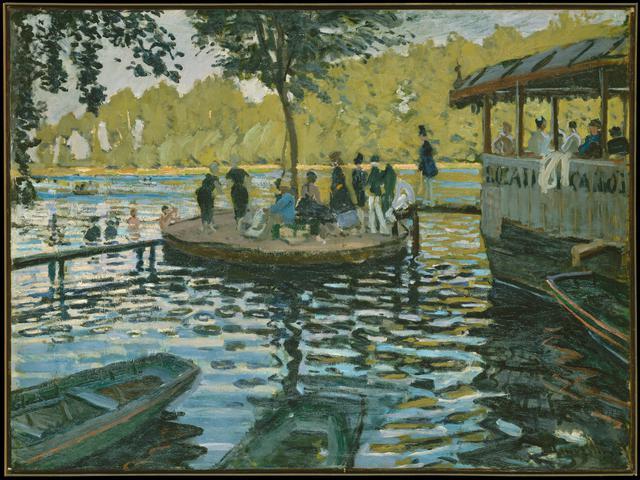Bath at La Grenouillere

This painting shows a popular boat and bathing establishment with an adjacent floating cafe, on the Seine, near Bougival, west of Paris. In the summer of 1869, Monet lived near La Grenouillère with his lover, Camille, and their son. Working alongside Renoir, he painted sketches of the scene in a very fresh and direct manner, possibly in preparation for a slightly larger canvas, now lost.
Monet's exceptionally free handling of the painting may be due in part to the canvas being a sketch of what was to be a more ambitious composition painted in the studio. It uses large areas of color to indicate moored boats in the shadows, while dots in the illuminated water in the background represent a group of bathers in the river.
The painting at the MET and one in the National Gallery, London (Bathers at La Grenouillere, oil on canvas, 73 x 92 cm) are probably the sketches mentioned by Monet in his letter. A larger painting, now lost but formerly in the Arnhold collection in Berlin, could well have been the "painting" he dreamed of. The broad, constructive brushstrokes here are clearly those of a sketch. For his exhibition paintings, Monet usually sought a more delicate and carefully calibrated surface at this time. An almost identical composition of the same theme by Renoir is in the Nationalmuseum, Stockholm. The two friends were undoubtedly working together.
Claude Monet, the driving force behind French Impressionism, specialized in plein air painting, a technique exemplified in this work, which also illustrates most of the characteristics of Impressionist painting of the period. Other Impressionists who dedicated themselves to plein air work were Camille Pissarro (1830-1903), Alfred Sisley (1839-1899) and, to a lesser extent, Auguste Renoir (1841-1919). In 1883, Monet settled in Giverny, where he created his famous water garden, and continued painting water lilies (see Decoration des Nympheas 1916-26, Musée de l'Orangerie, Paris) until his death, anticipating later 20th-century styles such as Abstract Expressionism (1945-1960).
© Tourblink